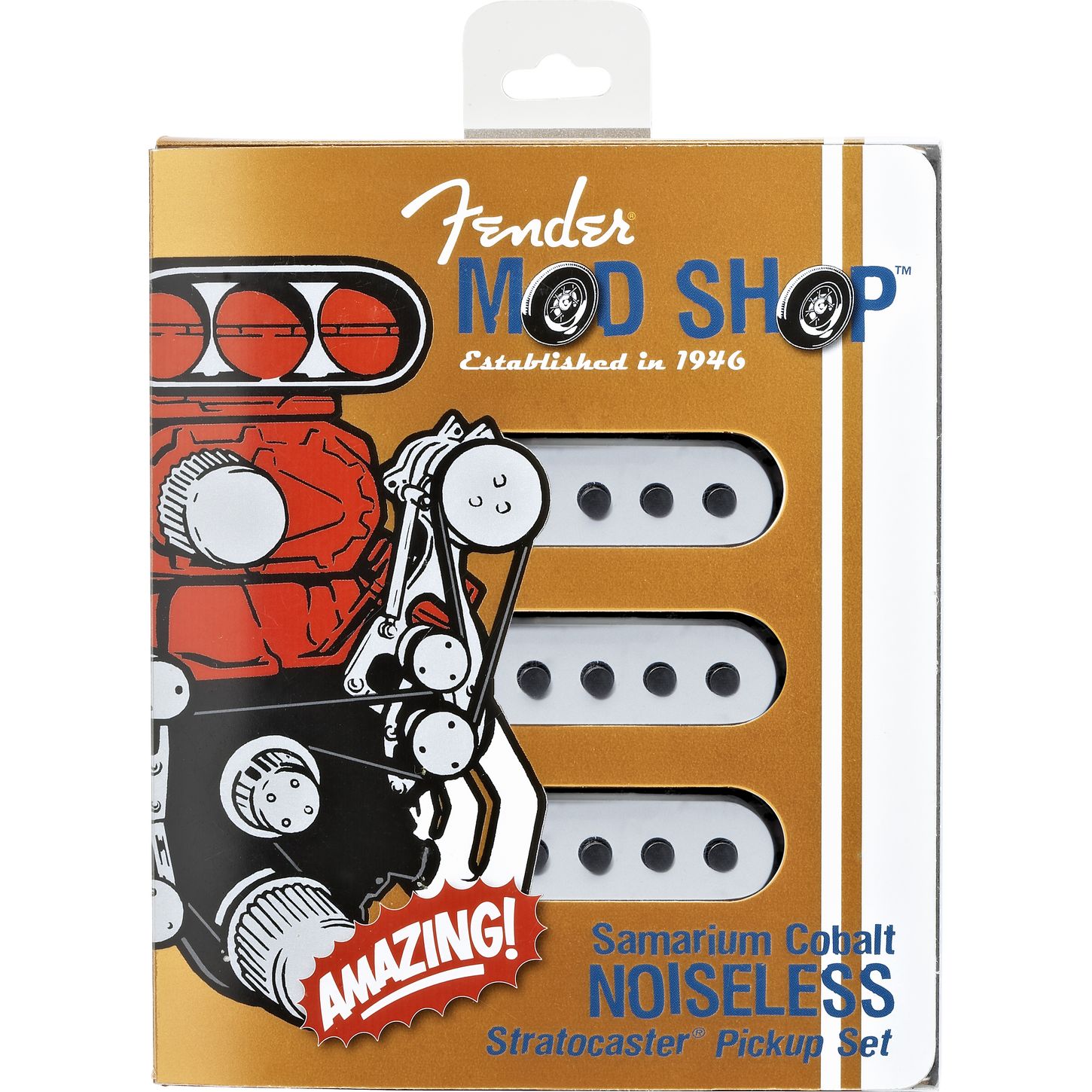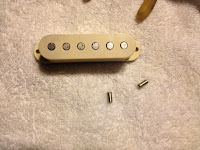Sunday, November 25, 2012
Rubbing resistor bad!
Here is a perfect example of what designers or even a hobbyists need to consider when placing circuits into metal enclosures. The picture shows a resistor that has been rubbing against the metal chassis inside a Vox amplifier. This resistor was part of the input circuit for the amp. The owner of the amp was experiencing buzzing and cutout of his guitar while playing. He would then adjust his cord going into the amp to releave the symptom. What he was actually doing was slightly moving the resistor away from the metal chassis. The process of plugging and unplugging the cable and moving it around on worsened the situation. All that needed to be done was simply bend the resistor down so that it was no longer touching the metal chassis. One thing to remember, if the resistor has been rubbing for awhile is maybe possible that the resistance had been changed. So I made sure to check it with an ohm meter just to be sure.
Fender Strat Pickup Repair
Pickup sounding weak or cuts out when you tap it? The following discovery and repair may save one from buying a new pickup, but at a cost.
Fender's SCN Samarium Cobalt noiseless pickups, are a set designed by the Fender Mod Shop. These pickups are designed to provide a huge bite, but noiseless. The magnets are a combination of traditional magnets and samarium magnetic material. A little off topic, but according to www.duramag.com; "Samarium Cobalt, rare earth magnet, is made up of largely Cobalt
and Samarium and it is the most expensive magnetic material to
manufacture and to fabricate." I had no idea there was such a material called samarium alloy.
First, let me explain the symptoms of this American strat that was brought to me. The middle pickup would cut out while playing and cause all kinds of noise and crackling. By tapping the pickup the sound would come back and then shortly after it would start all over again; very annoying! I personally never used the middle pickup on my strat, but on this strat the noise would be present even when switching between the neck and bridge pickups. This is a real problem.
Like all strats, the electronics are mounted to the pick guard. I relieved the tension on the strings, unscrewed the pick guard screws, and wiggled the pick guard away from the guitar. My first thought was that the pickup's solder joints were making contact with conductive paint that is in the guitars body cavity causing the pickup to ground out at that point. So my first solution is to add strips of tape on the back of the pickups and make sure that the pickups are at the proper height. This did not solve the issue. I was still getting crackling and had to tap the pickup to get the sound to come back.
Next, I decided to disassemble the pickup to get a better look at what is going on inside. Originally when I measured the resistance of the entire pickup coil, I would get nothing and when I would shake it a bit the meter would bounce to around 6 Kohms. According to the manufacturer the pickup should measure roughly 6.5 Kohms for the ST-MD model. It was fairly easy to take apart. Just needed to pop out the metal inserts for the pickup screws on each side and pull off the plastic cover to reveal the pickup coils and magnets.
After close inspection, I saw that a wire was laying across one coil and actually looked like it had melted the coating on the coil. This would make sense as the coil was terminated at that point on the coil causing the issue. This would reduce the resistance and the amount of turns. In fact, if it was touching so that the wire made contact with some where close to the beginning of the coil winding; there would be virtually nothing to pickup sound. It would be similar to shorting the ground and signal wire of your guitar together or using a piece of wire for a pickup. I carefully lifted the wire from the coil and de-soldered this wire from the pad and cut it loose. Then I took a measurement and the coil measured 12.7 Kohms. This is in-fact the true resistance of the coils as the design of this pickup allows a user to change the configuration of the pickup with a switch system. The noiseless feature that the pickup provides is from arranging the coils in a stacked formation. With a switching system, you can choose to use the pickup in a true single coil mode or in the mode that is similar to having a humbucker; which provides the noise canceling feature. This switching feature is called coil tapping.
To finish the repair I took a small piece of solid core wire and soldered it to the contact on the side between the coils and through the solder pad. I then made another check to confirm that the pickup did still have resistance and put everything back together. I tuned up the strat and played it for a bit to make sure the noise was truly gone and it was. Of course there is a downside to what had happened. The pickup no longer has the ability to cancel noise and is permanently a true single coil. So there is light hum like all single coils have, but switching between the pickups doesn't give the loud noise that was present before. The owner is happy so that is all that counts!
"image taken from www.musiciansfriend.com"
First, let me explain the symptoms of this American strat that was brought to me. The middle pickup would cut out while playing and cause all kinds of noise and crackling. By tapping the pickup the sound would come back and then shortly after it would start all over again; very annoying! I personally never used the middle pickup on my strat, but on this strat the noise would be present even when switching between the neck and bridge pickups. This is a real problem.
Like all strats, the electronics are mounted to the pick guard. I relieved the tension on the strings, unscrewed the pick guard screws, and wiggled the pick guard away from the guitar. My first thought was that the pickup's solder joints were making contact with conductive paint that is in the guitars body cavity causing the pickup to ground out at that point. So my first solution is to add strips of tape on the back of the pickups and make sure that the pickups are at the proper height. This did not solve the issue. I was still getting crackling and had to tap the pickup to get the sound to come back.
Next, I decided to disassemble the pickup to get a better look at what is going on inside. Originally when I measured the resistance of the entire pickup coil, I would get nothing and when I would shake it a bit the meter would bounce to around 6 Kohms. According to the manufacturer the pickup should measure roughly 6.5 Kohms for the ST-MD model. It was fairly easy to take apart. Just needed to pop out the metal inserts for the pickup screws on each side and pull off the plastic cover to reveal the pickup coils and magnets.
After close inspection, I saw that a wire was laying across one coil and actually looked like it had melted the coating on the coil. This would make sense as the coil was terminated at that point on the coil causing the issue. This would reduce the resistance and the amount of turns. In fact, if it was touching so that the wire made contact with some where close to the beginning of the coil winding; there would be virtually nothing to pickup sound. It would be similar to shorting the ground and signal wire of your guitar together or using a piece of wire for a pickup. I carefully lifted the wire from the coil and de-soldered this wire from the pad and cut it loose. Then I took a measurement and the coil measured 12.7 Kohms. This is in-fact the true resistance of the coils as the design of this pickup allows a user to change the configuration of the pickup with a switch system. The noiseless feature that the pickup provides is from arranging the coils in a stacked formation. With a switching system, you can choose to use the pickup in a true single coil mode or in the mode that is similar to having a humbucker; which provides the noise canceling feature. This switching feature is called coil tapping.
To finish the repair I took a small piece of solid core wire and soldered it to the contact on the side between the coils and through the solder pad. I then made another check to confirm that the pickup did still have resistance and put everything back together. I tuned up the strat and played it for a bit to make sure the noise was truly gone and it was. Of course there is a downside to what had happened. The pickup no longer has the ability to cancel noise and is permanently a true single coil. So there is light hum like all single coils have, but switching between the pickups doesn't give the loud noise that was present before. The owner is happy so that is all that counts!
Subscribe to:
Posts (Atom)















